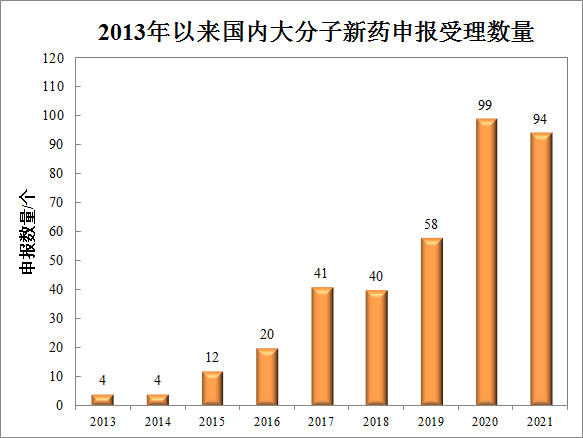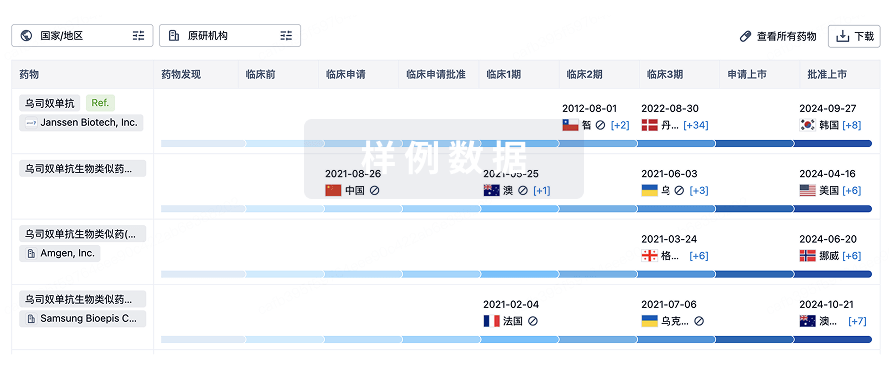预约演示
更新于:2025-12-06
Anti-CD47 antibody (Genrix Biopharmaceutical)
CD47单抗(智翔金泰)
更新于:2025-12-06
概要
基本信息
原研机构 |
在研机构- |
非在研机构 |
权益机构- |
最高研发阶段无进展药物发现 |
首次获批日期- |
最高研发阶段(中国)无进展 |
特殊审评- |
关联
100 项与 CD47单抗(智翔金泰) 相关的临床结果
登录后查看更多信息
100 项与 CD47单抗(智翔金泰) 相关的转化医学
登录后查看更多信息
100 项与 CD47单抗(智翔金泰) 相关的专利(医药)
登录后查看更多信息
34
项与 CD47单抗(智翔金泰) 相关的文献(医药)2025-08-01·BRITISH JOURNAL OF HAEMATOLOGY
The anti‐CD47 antibody magrolimab with obinutuzumab and venetoclax in relapsed or refractory indolent B‐cell lymphomas
Article
作者: Lakhotia, Rahul ; Phelan, James D. ; Melani, Christopher ; Tadese, Atekelt ; Gordon, Max J. ; Evans, Sarah ; Roschewski, Mark ; Pittaluga, Stefania ; Wilson, Wyndham H. ; Staudt, Louis M. ; Jaffe, Elaine S. ; Muppidi, Jagan R.
Follicular lymphoma (FL), marginal zone lymphoma (MZL), chronic lymphocytic leukaemia (CLL) and mantle cell lymphoma (MCL) are characterized by a continuous incidence of relapse and increasing resistance to therapy. Novel immunotherapy approaches are needed. Magrolimab, a CD47-blocking antibody, disrupts CD47:SIRPα-mediated antiphagocytic signalling. When combined with a prophagocytic signal from an anti-CD20 antibody rituximab, it has shown activity in relapsed or refractory FL and MZL. In this phase 1 study, adding the BCL2-inhibitor venetoclax to magrolimab and the anti-CD20 antibody obinutuzumab resulted in complete responses in 6 of 10 (60%) evaluable patients with FL, MZL or CLL. Notably, we did not observe increased risk of infections previously reported from studies of magrolimab in acute myeloid leukaemia and higher risk myelodysplastic syndromes.
2024-11-01·JOURNAL OF NEUROTRAUMA
Intravenous Administration of Anti-CD47 Antibody Augments Hematoma Clearance, Mitigates Acute Neuropathology, and Improves Cognitive Function in a Rat Model of Penetrating Traumatic Brain Injury
Article
作者: Houchins, Melonie ; Bailey, Zachary S. ; Yang, Fangzhou ; Carballo, Noemy ; Cardiff, Katherine ; Wang, Ping ; Yang, Xiaofang ; Scultetus, Anke H. ; Shear, Deborah A.
Traumatic brain injury (TBI)-induced intracerebral hematoma is a major driver of secondary injury pathology such as neuroinflammation, cerebral edema, neurotoxicity, and blood-brain barrier dysfunction, which contribute to neuronal loss, motor deficits, and cognitive impairment. Cluster of differentiation 47 (CD47) is an antiphagocytic cell surface protein inhibiting hematoma clearance. This study was designed to evaluate the safety and efficacy of blockade of CD47 via intravenous (i.v.) administration of anti-CD47 antibodies following penetrating ballistic-like brain injury (PBBI) with significant traumatic intracerebral hemorrhage (tICH). The pharmacokinetic (PK) profile of the anti-CD47 antibody elicited that antibody concentration decayed over 7 days post-administration. Blood tests and necropsy analysis indicated no severe adverse events following treatment. Cerebral hemoglobin levels were significantly increased after injury, however, anti-CD47 antibody administration at 0.1 mg/kg resulted in a significant reduction in cerebral hemoglobin levels at 72 h post-administration, indicating augmentation of hematoma clearance. Immunohistochemistry assessment of glial fibrillary acidic protein (GFAP) and ionized calcium-binding adaptor molecule 1 (IBA1) demonstrated a significant reduction of GFAP levels in the lesion core and peri-lesional area. Based on these analyses, the optimal dose was identified as 0.1 mg/kg. Lesion volume showed a reduction following treatment. Rotarod testing revealed significant motor deficits in all injured groups but no significant therapeutic benefits. Spatial learning performance revealed significant deficits in all injured groups, which were significantly improved by the last testing day. Anti-CD47 antibody treated rats showed significantly improved attention deficits, but not retention scores. These results provide preliminary evidence that blockade of CD47 using i.v. administration of anti-CD47 antibodies may serve as a potential therapeutic for TBI with ICH.
2024-07-19·Antibody therapeutics
A pan-allelic human SIRPα-blocking antibody, ES004-B5, promotes tumor killing by enhancing macrophage phagocytosis and subsequently inducing an effective T-cell response
Article
作者: Lu, Hongtao ; Sun, Dawei ; Guo, Xiaoli ; Sun, Jun ; Zhou, Hongping ; Qiu, Quan ; Gao, Rui ; Cui, Xue ; Lu, Yefeng ; Wang, Chunnian ; Jiang, Haixia ; Niu, Xiaofeng
Abstract:
As a major immune cell type in the tumor microenvironment, tumor-associated macrophages secrete suppressive factors that can inhibit antitumor immunity and promote tumor progression. One approach trying to utilize macrophages for immunotherapy has been to block the CD47-SIRPα axis, which mediates inhibitory signaling, to promote phagocytosis of tumor cells. Many CD47-targeted agents, namely, anti-CD47 antibodies and SIRPα fusion proteins, were associated with a diverse spectrum of toxicities that limit their use in clinical settings. Universal expression of CD47 also leads to a severe “antigen sink” effect of CD47-targeted agents. Given that the CD47 receptor, SIRPα, has a more restricted expression profile and may have CD47-independent functions, targeting SIRPα is considered to have distinct advantages in improving clinical efficacy with a better safety profile. We have developed ES004-B5, a potentially best-in-class pan-allelic human SIRPα-blocking antibody using hybridoma technology. ES004-B5 binds to major human SIRPα variants through a unique epitope with high affinity. By blocking CD47-induced inhibitory “don't-eat-me” signaling, ES004-B5 exerts superior antitumor activity in combination with anti-tumor-associated antigen antibodies in vitro and in vivo. Unlike CD47-targeted agents, ES004-B5 exhibits an excellent safety profile in nonhuman primates. ES004-B5 has potential to be an important backbone for SIRPα-based combination therapy and/or bispecific antibodies, which will likely overcome the limitations of CD47-targeted agents encountered in clinical settings.
2
项与 CD47单抗(智翔金泰) 相关的新闻(医药)2022-11-10
Nanotechnology platform enables immune conversion of cancer cells, sensitizing them to immunotherapy
A team of researchers has developed a nanotechnology platform that can change the way the immune system sees solid tumor cells, making them more receptive to immunotherapy. The preclinical findings suggest this adaptable immune conversion approach has the potential for broad application across many cancer types.
A team of researchers at The University of Texas MD Anderson Cancer Center has developed a nanotechnology platform that can change the way the immune system sees solid tumor cells, making them more receptive to immunotherapy. The preclinical findings suggest this adaptable immune conversion approach has the potential for broad application across many cancer types.
The study, published today in Nature Nanotechnology, details the use of this platform to artificially attach an activation molecule to the surface of tumor cells, triggering an immune response in both in vivo and in vitro models. Wen Jiang, M.D., Ph.D., assistant professor of Radiation Oncology, and Betty Kim, M.D., Ph.D., professor of Neurosurgery, co-led the study.
"With this new platform, we now have a strategy to convert a solid tumor, at least immunologically, to resemble a hematological tumor, which often has a much higher response rate to immunotherapy treatments," Jiang said. "If we are able to translate and validate this approach in the clinic, it may enable us to get closer to the maximum level of activity from immunotherapy drugs with cancers that have not traditionally responded well."
Immunotherapy has high response rates in blood cancers like leukemia and lymphoma, but success has been variable across solid tumors. Scientists have been working to further understand the mechanisms prohibiting a better response. One explanation is that varied expression of immune regulatory molecules on blood cancer versus solid tumor cells impact how they interact with immune cells.
The signaling lymphocytic activation molecule family member 7 (SLAMF7) receptor is critical in activating the body's immune cells against cancer cells, acting as an "eat me" signal. However, it is found almost exclusively on the surface of blood cancer cells and not in solid tumor cells, making it an attractive target for the researchers' immune conversion approach.
To promote the expression of SLAMF7 on solid tumor cells, the researchers developed their bispecific tumor-transforming nanoconjugate (BiTN) platform. These nanosystems are designed with one molecule to bind to the surface of targeted tumor cells and a second molecule to activate an immune response.
In this study, the researchers used BiTN with SLAMF7 and a HER2-recognizing antibody to target HER2-positive breast cancer cells. In laboratory models, the nanoconjugate successfully attached SLAMF7 to the breast cancer cells, resulting in phagocytosis, or ingestion, by immune cells. The approach also sensitized the breast cancer cells to treatment with an anti-CD47 antibody, which blocks the "don't eat me" signal from tumor cells to further increase responses in solid tumors.
According to the authors, one of the most exciting things about this platform is its broad potential applications. The approach would not be specific to one cancer type or one regulatory molecule, rather it has the potential to be a universal strategy for several different solid tumor types. As a proof of concept, the authors also developed BiTN with folate instead of the anti-HER2-antibody to target triple-negative breast cancer with similar results.
"Because these are engineered constructs, this can be used as a plug-and-play approach to incorporate different tumor-targeting agents or immune molecules onto the surface of the nanoparticle," Kim said. "For patients with solid tumors that have not responded to immunotherapy, we see this as an added advantage to target the part of the tumor that didn't respond."
The study was supported in part by the Susan G. Komen Foundation Career Catalyst Research Grant, the National Cancer Institute/National Institutes of Health (1K08 CA241070, P30 CA016672) and the United States Department of Defense.
免疫疗法
2021-07-11
·医药笔记
2015年以来,国内大分子新药申报开始呈现井喷趋势,2020年申报数量已经逼近三位数,2021年刚刚过半,申报数量已经接近100款。
热门靶点过度竞争正在PD-1之后其他靶点重现,HER2、IL-4R、IL-17、Claudin 18.2、CD47、多个checkpoint等都已经呈现类似趋势。
后续靶点中,细胞因子(IL-2、IL-15等)、腺苷通路(CD73/CD39/A2AR)、TSLP、Trop2、CD38等也正在吸引越
热门靶点过度竞争正在PD-1之后其他靶点重现,HER2、IL-4R、IL-17、Claudin 18.2、CD47、多个checkpoint等都已经呈现类似趋势。后续靶点中,细胞因子(IL-2、IL-15等)、腺苷通路(CD73/CD39/A2AR)、TSLP、Trop2、CD38等也正在吸引越来越多的药企布局。
越多的药企布局。
PD-1/PD-L1:双抗成竞争前沿
国内PD-1/PD-L1抗体的申报数量已经达到87款,其中PD-1单抗29个,PD-L1单抗19个,PD-1双抗或PD-L1双抗37个,四抗2个。国内方面,4款PD-1抗体已经上市,分别为君实生物、信达生物、恒瑞医药和百济神州。另有5款PD-1抗体(康方生物、誉衡药业、嘉和生物、复宏汉霖、乐普生物)申报上市,2款PD-L1抗体申报上市。FDA方面,君实生物、信达生物、康方生物已经申报上市,百济神州年内递交上市申请。
目前,PD-1/PD-L1单抗的申报已经很少,新一代的竞争集中在双抗。国内目前申报临床的69款双抗中,37款即超过一半为PD-1双抗或PD-L1双抗。这些PD-1双抗或PD-L1双抗中,康方生物的PD-1/CTLA-4双抗AK104在多个适应症早期临床取得优异数据,一些适应症疗效数据优于PD-1+CTLA-4联合治疗的历史数据,而安全性更具有显著优势。AK104不仅在国内居于领先地位,在国际上也是进展最快的免疫双抗之一,未来将不断创造新的纪录。
除PD-1/CTLA-4或PD-L1/CTAL-4外,PD-(L)1/CD47、PD-(L)1/VEGF、PD-(L)1/TGFβ、PD-(L)/4-1BB、PD-(L)1/LAG-3双抗等也是PD-(L)1双抗的靶点组合。
需要注意的是,有些机制的
双抗不一定是最好的组合,需要具体情况具体分析,
如罗氏PD-L1+VEGF联合治疗在肝癌取得成功,但其实PD-1抗体+小分子血管抑制剂如仑伐替尼等取得了更好的数据。
2021年6月28日,信达生物宣布NMPA批准PD-1抗体信迪利单抗联合贝伐珠单抗类似药一线治疗晚期肝细胞癌。相比于索拉非尼,该联合治疗将ORR从8%提高到21%,mPFS从2.8个月延长到4.6个月。此外,多家
国内多家药
以PD-1
与仑伐替尼联合,
康方生物则以PD-1/CTLA-4双抗与
仑伐替尼联合,随访2.7个月即取得优异疗效数据,媲美乃至超过其他PD-1联合VEGF抗体或仑伐替尼随访10个月的疗效数据。
其他免疫检验点:TIGIT、LAG-3等
今年ASCO会议,一个重要看点就是LAG-3联合Opdivo黑色素瘤三期临床,意味着又一个新的免疫检验点获得成功。国内已经申报多款LAG-3融合蛋白、单抗和双抗。
今年ASCO前后,TIGIT靶点成为跨国药企布局的重要靶点。百时美施贵宝15.6亿美元引进Agenus的TIGIT双抗,葛兰素史克20.7亿美元引进iTeos的TIGIT单抗。国内已经申报6款TIGIT单抗和1款PD-1/TIGIT双抗。复宏汉霖与北生所隋建华课题组均研发了基于DLE增强Fc effector效应,进而增强抗肿瘤活性的TIGIT抗体。
PD-L1/4-1BB为热门的双抗靶点组合,
国内已经申报7款4-1BB单抗、4款PD-L1/4-1BB双抗(科望生物、齐鲁制药、基石药业、普米斯生物)、1款PD-1/4-1BB双抗(信达生物),百利药业的3款四抗则为PD-L1/4-1BB/CD3/TAA。此外,维立志博、德琪医药的PD-L1/4-1BB双抗也将很快进入临床阶段。礼进生物则通过Fc突变,增强FcγRIIb亲和力,通过Cross-linking以增强抗肿瘤活性。
Yervoy虽然早早获批,但是安全性是一个巨大问题。国内药企很多在开发新一代的CTLA-4单抗或双抗,如康方生物CTLA-4抗体成为默沙东免疫联合治疗的重要角色,昂科免疫研发pH依赖性的CTLA-4抗体,可能更有效更安全。
OX40抗体和CD40抗体,目前申报临床还不太多,分别为6家和4家,信达生物等在研发PD-L1/OX40双抗,百奥赛图在研发PD-1/CD40双抗等。
CD47:形势渐渐明朗
国内CD47靶点竞争极为激烈,申报临床接近20款,包括SIRPα融合蛋白、单抗、双抗等。
SIRPα融合蛋白、CD47抗体、SIRPα抗体都有药企布局。
尽管FortySeven之后,很多药企宣称筛到了没有血液毒性的CD47单抗,Trillium也称SIRPα融合蛋白没有血液毒性。但目前来看,Magrolimab之后,SIRPα融合蛋白或新一代CD47抗体确实血液毒性显著更弱,但仍然有一定的血液毒性。以Trillium为例,同时开发IgG1和IgG4亚型的SIRPα融合蛋白,并将IgG1亚型作为重点。从今年ASCO前后,Trillium的重心已经装箱IgG4,很大的一个原因就是TTI-621因为毒性问题(如血小板毒性)只能爬坡到2mg/kg剂量,而TTI-622已经爬坡到18mg/kg,在不同治疗窗口下,TTI-622取得更好疗效,且安全性仍好于TTI-622。目前天境生物、康方生物的CD47抗体已经爬坡到30mg/kg甚至更高,未来IgG4亚型的SIRPα融合蛋白或CD47抗体,将成为该通路的主要力量,后续则重点关注双抗和联合治疗。
腺苷通路:CD39、CD73、A2AR
CD39-CD73-腺苷通路
是免疫抑制环境的重要参与者之一:ATP在CD39作用下转化为AMP,AMP在CD73作用下转化为腺苷,腺苷与免疫细胞
上的受体结合产生免疫抑制效应。
国内已经申报4款CD73抗体,岸迈生物等布局CD39抗体,另有多家药企开发A2AR抑制剂。
细胞因子:IL-2、IL-15、IL-21等
恒瑞医药申报了首个IL-2,目前也是唯一处于临床阶段的国产IL-2。信达生物自主研发了IL-2,君实生物引进了Anwita和志道生物的IL-2,先声药业引进了CD80/IL-2融合蛋白。
恒瑞医药和博际生物申报了IL-15,先声药业研发了PD-L1抗体/IL-15融合蛋白,诺诚健华等也在布局(下图)。
君实生物申报了国内首个IL-21融合蛋白。
天境生物为IL-7的领先者(从Genexine引进),并开发基于IL-7的多个抗体融合蛋白。
丁孚靶点研发了EGFR抗体/IL-10融合蛋白,已经进入临床研究阶段。2019年6月,该融合蛋白的作用机制研究
发表在Cancel Cell期刊上,通讯作者为徐霆博士、傅阳心教授以及西南医学中心的乔健博士。
2020年4月,傅阳心教授也发表了一篇EGFR抗体/IL-21融合蛋白的研究文章。
Claudin 18.2
胃癌为亚洲国家高发癌种,国内Claudin 18.2的竞争异常激烈,目前刚开布局者已经超过30家。药物形式方面,单抗、多抗、ADC和CAR-T同台竞争。
科济药业Claudin 18.2 CAR-T初步临床数据如下,ORR为50%,中位DoR为4.6个月。
康诺亚/乐普生物的CMG901为全球首个Claudin 18.2 ADC新药,临床前研究发现抗肿瘤活性显著优于Claudin 18.2单抗。
ADC靶点:HER2、Trop2等
国内ADC很长时间内对标T-DM1,造成单一靶点过度竞争。随着新一轮ADC热潮了来临,Trop2等成为新的热门靶点,目前国内已经有6款Trop2 ADC申报,其中百奥泰已经终止,剩余5家。HER2则进入新一代的竞争,至少对标T-DM1,同时要面临DS-8201的竞争。新码生物的ARX788、科伦药业的A166都表现出不错的疗效数据,ARX788在安全性上优势则更为明显。
多发性骨髓瘤:CD38、BCMA
多发性骨髓瘤大分子新药的竞争聚焦在CD38-BCMA-GPRC5D,国内已经申报3款CD38单抗,1款CD38/CD3双抗和3款BCMA/CD3双抗。强生GPRC5D/CD3已经取得很好的临床数据,优瑞科与MSKCC联合研发的GPRC5D CAR-T也刚刚与赛诺菲达成重磅交易。
Th2通路:特异性皮炎和哮喘等
Th2通路在湿疹和哮喘的研究已经非常清楚,2020年Dupixent销售额已经达到40亿美元。国内已经申报7款IL-4R抗体、2款IL-5抗体和2款TSLP抗体。
康诺亚在IL-4R抗体和TSLP抗体都处于第一名的位置,是国内Th2通路当之无愧的领导者。IL-4R抗体
CM310起效比dupixent更快,给药后7天TRAC即显著下降, 而Dupilumab给药后15天才有显著下降。
治疗特应性皮炎的1b/2a期临床中,CM310给药后6周的疗效数据即超过Dupilumab治疗16周的数据。CM310有望成为同类最佳的IL-4R抗体。
安进/阿斯利康的TSLP抗体已经申报上市,康诺亚国内申报了首个TSLP抗体CM326。CM326的体外生物学活性比Tezepelumab强5倍左右。
Th17通路:银屑病等
Th17通路在银屑病、银屑病关节炎、强制性脊柱炎等取得成功,欧美已经上市多款IL-17抗体和IL-23抗体。2020年,Th17通路抗体药物市场规模已经达到150亿美元。
从欧美大量头对头临床试验可以看出,IL-23抗体和IL-17A/F普遍表现出比IL-17抗体更好的疗效。国内IL-17靶点中,仅鑫康合/丽珠单抗开发的是IL-17A/F抗体,其他均为IL-17A抗体。
抗病毒:泰诺麦博、迈威生物等
国内研发抗病毒抗体的相对较少,目前仅泰诺麦博、迈威生物、华北制药和智翔医药等申报了抗病毒抗体。泰诺麦博的主要技术平台为人单B细胞测序。由于自身免疫耐受的限制,天然全人源抗体更易于获得针对外源抗原的克隆,抗病毒抗体即一个理想领域。新冠疫情中,Vir Bio、再生元、中微所/君实生物、清华大学/腾盛博药、丹序生物/百济神州的中和抗体都来自于康复患者的天然全人源抗体。
迈威生物则与同济大学安毛毛团队合作,开发多个抗病毒或抗细菌抗体新药。
凝血或抗凝血:FXI、TFPI
TFPI通过抑制FVIIa-TF-FXa复合物削弱外源性凝血途径,康宁杰瑞KN057为国内首个TFPI抗体。
FXI抗体则用于抗凝,科伦药业申报了国内首个FXI抗体SKB336。仁会生物、博槿生物等也在布局。不过根据拜耳Osocimab的数据,抗凝效果优于依诺肝素,但与阿哌沙班相比,未达到非劣效终点。
仁会生物、博槿生物
FXI抗体则用于抗凝,科伦药业申报了国内首个FXI抗体SKB336。仁会生物、博槿生物等也在布局。不过根据拜耳Osocimab的数据,抗凝效果优于依诺肝素,但与阿哌沙班相比,未达到非劣效终点。
Osocimab的
FXI抗体则用于抗凝,科伦药业申报了国内首个FXI抗体SKB336。仁会生物、博槿生物等也在布局。不过根据拜耳Osocimab的数据,抗凝效果优于依诺肝素,但与阿哌沙班相比,未达到非劣效终点。
补体系统
2020年12月,阿斯利康以390亿美元收购Alexion,补体药物一时备受关注。前不久,Apellis的C3靶向环肽获得FDA批准,疗效显著优于Alexion的C5抗体Soliris。
国内方面,天境生物申报了C5aR抗体,康景生物申报了CRIg-CFH融合蛋白,信达生物申报了VEGFR/CR1融合蛋白。此外,科越医药(C5抗体/CFH融合蛋白)、天辰生物、康诺亚(MASP-2抗体)、康普美特等也在布局补体药物。
系统性红斑狼疮:BLyS、IFNAR1
葛兰素史克BLyS抗体贝利木单抗为FDA五十多年批准的第一款狼疮新药。荣昌生物的泰它西普为TACI-Fc融合蛋白,已经获批上市。
安进/百济神州申报了BLyS/ICOS双功能蛋白AMG 570。
非主流靶点或治疗领域:Aβ等
随着过度竞争日趋激烈,越来越多的药企尝试布局更为偏僻的赛道或靶点。如恒瑞医药申报了首个Aβ抗体,用于治疗阿尔茨海默症。柯华珠博士创立安济盛,聚焦骨科新药的研发,已经申报DKK1。安源医药申报了首个FGF21-Fc融合蛋白,东阳光申报了首个GLP-1/FGF21双功能融合蛋白。多禧生物申报了首个国产MUC1 ADC新药,思路迪申报了首个AXL-GAS6通路的GAS融合蛋白。鸿运华宁聚焦GPCR抗体研发,申报了GLP-1R抗体/GLP-1融合蛋白。
KRAS G12C
相比于大分子,小分子领域的过度竞争不遑多让。
以KRAS G12C为例,短短两年时间里,公开布局的药企已经
相比于大分子,小分子领域的过度竞争不遑多让。以KRAS G12C为例,短短两年时间里,公开布局的药企已经接近30家。
30家。
总结
国内的新药研发格局,许多热门靶点的竞争依然非常激烈,并不断在新获验证的潜在明显靶点重复相同的故事。与此同时,也要注意药企普遍以差异化设计为底线,以寻求潜在的临床优势。抗体工程(如礼进xLinkAb技术改进crosslinking、百济神州去除PD-1抗体的ADCP效应)、新药物形式(如Claudin 18.2靶点,双抗、ADC、CAR-T均有药企布
局)、双抗靶点理性组合与设计(如康方生物的PD-1/CTLA-4双抗)、联合治疗探索等。与此同时,也有越来越多的企业积极布局原创创新,如Immune-Onc的髓系细胞检验点、石药集团的Cx43抗体等等,多采取与顶尖华人科学家合作,基于其基础研究进行转化。
无论是基于新技术寻求BIC,还是基于创新性基础研究寻求FIC,最终落点都在于临床价值和患者需求。可预见的时间里,me-better或BIC仍然是中国生物医药的主要创新力量,FIC也将在踏实的积累之下慢慢成长。
免责声明
“药渡”公众号所转载文章来源于其他公众号平台,主要目的在于分享行业相关知识,传递当前最新咨询。图片,文章版权均属于原作者所有,如有侵权,请及时告知,我们会在24小时内删除相关信息。

抗体免疫疗法抗体药物偶联物ASCO会议小分子药物
100 项与 CD47单抗(智翔金泰) 相关的药物交易
登录后查看更多信息
研发状态
10 条进展最快的记录, 后查看更多信息
登录
| 适应症 | 最高研发状态 | 国家/地区 | 公司 | 日期 |
|---|---|---|---|---|
| 肿瘤 | 药物发现 | 中国 | 2019-03-07 |
登录后查看更多信息
临床结果
临床结果
适应症
分期
评价
查看全部结果
| 研究 | 分期 | 人群特征 | 评价人数 | 分组 | 结果 | 评价 | 发布日期 |
|---|
No Data | |||||||
登录后查看更多信息
转化医学
使用我们的转化医学数据加速您的研究。
登录
或

药物交易
使用我们的药物交易数据加速您的研究。
登录
或

核心专利
使用我们的核心专利数据促进您的研究。
登录
或

临床分析
紧跟全球注册中心的最新临床试验。
登录
或

批准
利用最新的监管批准信息加速您的研究。
登录
或

生物类似药
生物类似药在不同国家/地区的竞争态势。请注意临床1/2期并入临床2期,临床2/3期并入临床3期
登录
或

特殊审评
只需点击几下即可了解关键药物信息。
登录
或

生物医药百科问答
全新生物医药AI Agent 覆盖科研全链路,让突破性发现快人一步
立即开始免费试用!
智慧芽新药情报库是智慧芽专为生命科学人士构建的基于AI的创新药情报平台,助您全方位提升您的研发与决策效率。
立即开始数据试用!
智慧芽新药库数据也通过智慧芽数据服务平台,以API或者数据包形式对外开放,助您更加充分利用智慧芽新药情报信息。
生物序列数据库
生物药研发创新
免费使用
化学结构数据库
小分子化药研发创新
免费使用
